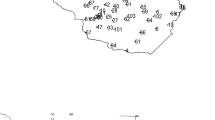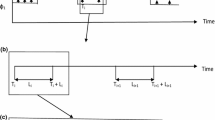Summary
For six stations in central Australia daily rainfalls were combined over five-day intervals. The resulting pentads were classed as either wet or dry according to whether a total of at least 0.1 inch of rain had occurred. A first order Markov model and a simple random model were constructed for the distribution of runs of wet and dry pentads. A χ2 test showed that the random model gives a poor fit to the observed frequencies. With the Markov model, however, good agreement was obtained with the exception of a few cases. Although the Markov model could be further improved it seems to be a practical statistical tool for assessing the long-term incidence of runs of wet or dry weather in central Australia.
Zusammenfassung
Für sechs Stationen in Mittelaustralien wurden tägliche Niederschlagssummen zu Pentaden-Summen zusammengefaßt. Die resultierenden Pentaden wurden als naß oder trocken klassifiziert, je nachdem, ob wenigstens 2,5 mm Regen gefallen war oder nicht. Für die Verteilung von Folgen von trokken und nassen Pentaden wurden ein Markov-Modell 1. Ordnung und ein einfaches Zufallsmodell konstruiert. Ein χ2 zeigte, daß das Zufallsmodell die beobachteten Häufigkeiten nur schlecht wiedergibt. Mit dem Markov-Modell wurde dagegen, mit Ausnahme einiger Fälle, gute Übereinstimmung erzielt. Obwohl das Markov-Modell noch weiter verbessert werden könnte, scheint es eine praktische Möglichkeit zur Darstellung länger dauernder Folgen von nassen oder trockenen Pentaden in Mittelaustralien zu bieten.
Résumé
On a établi les sommes pentadaires des précipitations de six stations d'Australie centrale. Les groupes de cinq jours ainsi établis sont répartis en deux classes, humides ou secs selon que la dite somme dépasse 2,5 mm de pluie ou non. Pour l'étude de la répartition de successions de pentades humides ou sèches on a construit un modèle de Markov du premier ordre et un modèle aléatoire simple. Un examen au mogen du teste χ2 a montré que lemodèle aléatoire ne reflète que très mal fréquences observées. On obtient par contre, quelques cas exceptés, une assez bonne coïncidence avec le modèle de Markov. Bien que ce dernier puisse encore être amélioré, il semble présenter une possibilité pratique pour la représentation de successions importantes de pentades humides ou sèches en Australie centrale.
Similar content being viewed by others
References
Blumenstock, G.: Drought in the United States Analyzed by Means of the Theory of Probability. U. S. Dept. Agric. Techn. Bull. No. 819 (1942).
Caskey, J. E.: A Markov Chain Model for the Probability of Precipitation Occurrence in Intervals of Various Length. Monthly Weather Rev.91, 298–301 (1963).
Feyerherm, A. M., andL. D. Bark: Statistical Methods for Persistent Precipitation Patterns. J. Appl. Meteor.4, 320–328 (1965).
Fitzpatrick, E. A.: Probability Analysis of Rainfall Factors in Drought in New South Wales. Thesis published by the Rural Bank of New South Wales, Sydney (1953).
Fitzpatrick, E. A.: Seasonal Distribution of Rainfall in Australia Analysed by Fournier Methods. Arch. Met. Geoph. Biokl., B13, 270–286 (1964).
Gabriel, K. R., andJ. Neumann: A Markov Chain Model for Daily Rainfall Occurrences at Tel Aviv. Quart. J. Roy. Meteor. Soc.88, 90–95 (1962).
Hartley, H. O.: Tests of Significance in Harmonic Analysis. Biometrika36, 194–201 (1949).
Pattison, A.: Synthesis of hourly rainfall data. Water Resources Research1, 489–498 (1965).
Slatyer, R. O.: Climate of the Alice Springs Area. CSIRO Aust. Land Research Series No. 6, 109–128 (1962).
Weiss, L. L.: Sequences of Wet or Dry Days Described by a Markov Chain Probability Model. Monthly Weather Rev.92, 169–176 (1964).
Wiser, E. H.: Modified Markov Probability Models of Sequences of precipitation Events. Monthly Weather Rev.93, 511–516 (1965).
Author information
Authors and Affiliations
Additional information
With 2 Figures
Rights and permissions
About this article
Cite this article
Fitzpatrick, E.A., Krishnan, A. A first-order Markov model for assessing rainfall discontinuity in central Australia. Arch. Met. Geoph. Biokl. B. 15, 242–259 (1967). https://doi.org/10.1007/BF02243854
Received:
Issue Date:
DOI: https://doi.org/10.1007/BF02243854




